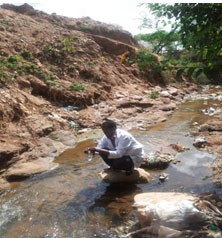Monitoring and regulation
Monitoring of the quality of rivers (Figure 4.10) can be done at regular intervals by taking samples for laboratory analysis. In Ethiopia this activity is undertaken by the Ministry of the Environment and Forests. In addition to this, regular surveys of a catchment area are useful so that potential pollutants can be identified before they contaminate a water source.

Figure 4.10 A technician monitoring water quality.
For effective protection of water sources, it is important to establish a regulatory framework for treatment of wastewater from residential communities, institutions and industries. Strict legislation should be in place to make it obligatory for wastewaters to be treated before discharge into rivers or lakes. Ethiopia has the Ethiopian Water Resources Management Regulations (Council of Ministers, 2005). Part 4 of these regulations states that a permit to discharge wastewater must be obtained for the ‘direct or indirect discharge of any treated trade effluent or sewage effluent, or any poisonous, noxious or polluting matter into surface or ground water’. Anyone who obtains the permit has an obligation to install and use the best treatment method and to discharge only the type and volume of treated waste permitted.
Control of water pollution is the responsibility of more than one organisation, since most activities involving water concern a number of different Ministries. For instance, water use in agriculture would be of concern to the Ministry of Agriculture, the Ministry of Water Resources, Irrigation and Energy, and the Ministry of the Environment and Forests, and all of them have the responsibility of protecting the environment.